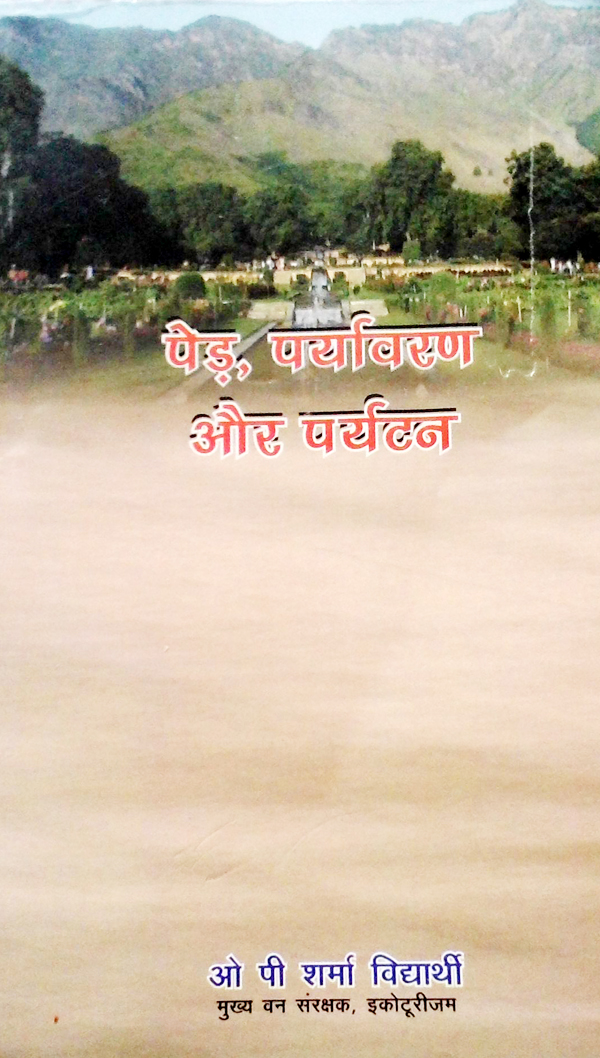Suman K. Sharma
Today, when the printed word is increasingly losing ground to the electronic media, we expect a book for the general reading to have certain qualities – it should be fun to read, broaden our vision without being ‘too heavy’ and serve as a reference tool by our bedside. O.P. Sharma Vidyarathi’s latest Hindi work Ped, Paryavaran aur Pyartan (Maanavi Prakashan, Panjteerthi, Jammu) is one such book. 54-year old Vidyarathi, currently J&K’s chief conservator of forests, holds a post-graduate degree in Botany and has authored 38 books till date, including the 2002-Sahitya Akademy award winning Dogri travelogue, Trip Trip Chete (self-translated into Hindi under the title Boond Boond Smritiyan). But more than his 27 years with the Indian Forest Service, or even his undeniable penchant for writing quality prose as well as poetry, it is Vidyarathi’s abiding love for nature that glows in this little gem of a book on eco-tourism. ‘The main objective of Ped…’ writes Maharaj Krishan Santoshi in his Foreword, ‘is to enhance peoples’ knowledge about (their) environment and invoke in them the love for nature.’
The book is organized into 10 sections, including a 7-page glossary of over 200 useful terms in English, Hindi and Dogri and a 14-page photo-profile containing pictures of the flora, fauna and places of tourist interest in the state. It covers diverse aspects of the main subject in a charming narrative: Environment and Vegetation (Section 1), Wild Animals and their Habitats (Section 2), Environment and Tree-talk (Section 3), Environment and Bio-diversity (Section 4), Flowers, Leaves and Trees (Section 5), and Amazing Games Birds and Beasts Play (Section 6). Section 7, titled ‘Insect-eating Plants,’ renders some interesting facts about carnivorous plants of our state. This section also contains half a dozen poems of varying length and impact.
The tone of the book is set in the opening paragraph of Section 1 itself:
‘Prakriti sunder saloni, manohaari jeevan ki adhaar, charon aur ped parinde, patjhad bahaar, saath saath keet patange, bhanvare titliyon ka pyar, rang birange pushp, pahaadon par saghan devdar kayal, monal ki anupam sunder udaan, van van parindon ka izhaar, basant mein eka-ek sunder udyaan van van tesu shobhaymaan, amaltaas kahin, kahin anaar ke guldaan….’ (p.1).
– Nature, beautiful and alluring – the mainstay of charming life enduring; birds and trees abounding in directions all, be it the Spring or the Fall; insects and worms together in peace, the passion of butterflies and bumble bees; the variegated splendor of surfeit of flowers, the hills lush with thick Deodar and Kayal bowers; the exquisite Monal soaring, the jungles alive with bird-songs alluring; the gardens out-doing each other in the Spring’s sudden magnificence, the Palaash forests painted gay with Tesu in abundance; the graceful Amaltas here, a bouquet of pomegranate there….’
As it happens often, the symphony of the original is lost in translation. Reading it in original would leave you wondering whether it is poetry in prose or prose in poetry. But in no case is it a dry and bland ‘sarkari’ report of a top forest functionary on his domain. And the author goes on and on in this vein, knitting before your eyes by the sheer magic of his words the ebullience of wilderness, spattering the whole v-i-b-g-y-o-r on the earth, orchestrating a zillion notes of happy trills and cries of birds.
Vidyarathi’s achievement as an author lies in sharing his specialized knowledge without seeming to be talking down to the lay reader. Bits of interesting information lie embedded in the text like tasty nuggets in a gravy – that pre-historic pit-dwellers of of Burjahoma near Dachigram National Park in Kashmir lived in dwellings made of papyrus trees (p.3); that the land-locked Jammu province has several species of crustaceans (creatures whose soft bodies are protected by hard shells) which are normally found on sea-shores (p.3); that the algae locally known as ‘Kara’ is distinctive to Jammu province (p.9); that the renowned entomologist from Jammu, Prof Baldev Sharma, discovered several new species of insects in the land of his birth and named them in the honour of his kin, birthplace and of course his mentor – Jammuana umashankari, for instance (pp.10-11); that some animals and plants such as ghadiyal and Nilgiri ginger are found nowhere else but India in their natural habitat (p.27). The author has taken pains to give each plant and creature its local Dogri or Kashmiri name, the Hindi equivalent and of course its Botanical name as well, so as to leave no doubt in the reader’s mind as to the subject’s identity. Snippets from history, legend and mythology have been added to adorn and amplify the narration. There is that moving reference to the Queen Habba Khatoon of 16th century Kashmir, repining over the loss of her beloved husband, King Yusuf Shah, who was held captive by the devious Mughal Emperor Akbar and sent far away to Bihar to spend the rest of his days in misery and isolation.
Habba Khatoon has been immortalized by a beautiful mountain in Gurez being named after her (p.13). All through the narrative, there is a subtle underpinning of the need to conserve the fragile ecosystem which is being ravaged for short-term gains. The book will be of immense interest to the student community and tourists.
On the flip side, one is constrained to say that the vibrant subject of the book and its lively treatment did deserve a more imaginative cover design. Honestly, a well-designed coffee-table book would have served the author’s intent much better.


